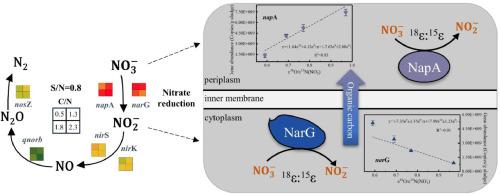当前位置:
X-MOL 学术
›
Water Res.
›
论文详情
Our official English website, www.x-mol.net, welcomes your feedback! (Note: you will need to create a separate account there.)
Impact of organic carbon on sulfide-driven autotrophic denitrification: Insights from isotope fractionation and functional genes
Water Research ( IF 12.8 ) Pub Date : 2024-03-23 , DOI: 10.1016/j.watres.2024.121507 Mengjia Zhan , Wei Zeng , Congcong Wu , Gangxin Chen , Qingan Meng , Xiaojing Hao , Yongzhen Peng
Water Research ( IF 12.8 ) Pub Date : 2024-03-23 , DOI: 10.1016/j.watres.2024.121507 Mengjia Zhan , Wei Zeng , Congcong Wu , Gangxin Chen , Qingan Meng , Xiaojing Hao , Yongzhen Peng

|
Additional organics are generally supplemented in the sulfide-driven autotrophic denitrification system to accelerate the denitrification rate and reduce sulfate production. In this study, different concentrations of sodium acetate (NaAc) were added to the sulfide-driven autotrophic denitrification reactor, and the S accumulation increased from 7.8% to 100% over a 120-day operation period. Batch experiments revealed a threefold increase in total nitrogen (TN) removal rate at an Ac-C/N ratio of 2.8 compared to a ratio of 0.5. Addition of organic carbon accelerated denitrification rate and nitrite consumption, which shortened the emission time of NO, but increased the NO production rate. The lowest NO emissions were achieved at the Ac-C/N ratio of 1.3. Stable isotope fractionation is a powerful tool for evaluating different reaction pathways, with the ε/ε values in nitrate reduction ranging from 0.5 to 1.0. This study further confirmed that isotope fractionation can reveal denitrifying nutrient types, with the ε (isotopic enrichment factor of oxygen)/ε (isotopic enrichment factor of nitrogen) value approaching 1.0 for autotrophic denitrification and 0.5 for heterotrophic denitrification. Additionally, the ε/ε values can indicate changes in nitrate reductase. There is a positive correlation between the ε/ε values and the abundance of the functional gene A, and a negative correlation with the abundance of the gene G. Moreover, ε and ε were associated with changes in kinetic parameters during nitrate reduction. In summary, the combination of functional gene analysis and isotope fractionation effectively revealed the complexities of mixotrophic denitrification systems, providing insights for optimizing denitrification processes.
中文翻译:

有机碳对硫化物驱动的自养反硝化的影响:来自同位素分馏和功能基因的见解
在硫化物驱动的自养反硝化系统中通常会补充额外的有机物,以加快反硝化速度并减少硫酸盐的产生。在本研究中,在硫化物驱动的自养反硝化反应器中添加不同浓度的乙酸钠(NaAc),在120天的运行期内,S积累量从7.8%增加到100%。批量实验表明,Ac-C/N 比为 2.8 时,总氮 (TN) 去除率比 0.5 时增加了三倍。有机碳的添加加速了反硝化速率和亚硝酸盐的消耗,缩短了NO的排放时间,但提高了NO的生成率。当 Ac-C/N 比为 1.3 时,NO 排放量达到最低。稳定同位素分馏是评估不同反应途径的有力工具,硝酸盐还原中的 ε/ε 值范围为 0.5 至 1.0。本研究进一步证实同位素分馏可以揭示反硝化营养物类型,自养反硝化的ε(氧同位素富集因子)/ε(氮同位素富集因子)值接近1.0,异养反硝化接近0.5。此外,ε/ε 值可以指示硝酸还原酶的变化。 ε/ε值与功能基因A的丰度呈正相关,与基因G的丰度呈负相关。此外,ε和ε与硝酸盐还原过程中动力学参数的变化有关。总之,功能基因分析和同位素分级分离的结合有效地揭示了混合营养反硝化系统的复杂性,为优化反硝化过程提供了见解。
更新日期:2024-03-23
中文翻译:

有机碳对硫化物驱动的自养反硝化的影响:来自同位素分馏和功能基因的见解
在硫化物驱动的自养反硝化系统中通常会补充额外的有机物,以加快反硝化速度并减少硫酸盐的产生。在本研究中,在硫化物驱动的自养反硝化反应器中添加不同浓度的乙酸钠(NaAc),在120天的运行期内,S积累量从7.8%增加到100%。批量实验表明,Ac-C/N 比为 2.8 时,总氮 (TN) 去除率比 0.5 时增加了三倍。有机碳的添加加速了反硝化速率和亚硝酸盐的消耗,缩短了NO的排放时间,但提高了NO的生成率。当 Ac-C/N 比为 1.3 时,NO 排放量达到最低。稳定同位素分馏是评估不同反应途径的有力工具,硝酸盐还原中的 ε/ε 值范围为 0.5 至 1.0。本研究进一步证实同位素分馏可以揭示反硝化营养物类型,自养反硝化的ε(氧同位素富集因子)/ε(氮同位素富集因子)值接近1.0,异养反硝化接近0.5。此外,ε/ε 值可以指示硝酸还原酶的变化。 ε/ε值与功能基因A的丰度呈正相关,与基因G的丰度呈负相关。此外,ε和ε与硝酸盐还原过程中动力学参数的变化有关。总之,功能基因分析和同位素分级分离的结合有效地揭示了混合营养反硝化系统的复杂性,为优化反硝化过程提供了见解。



























 京公网安备 11010802027423号
京公网安备 11010802027423号